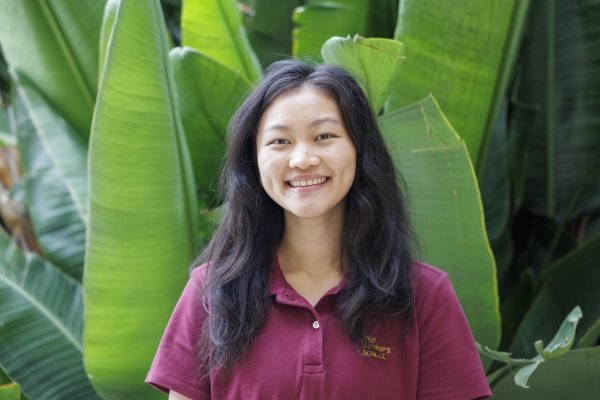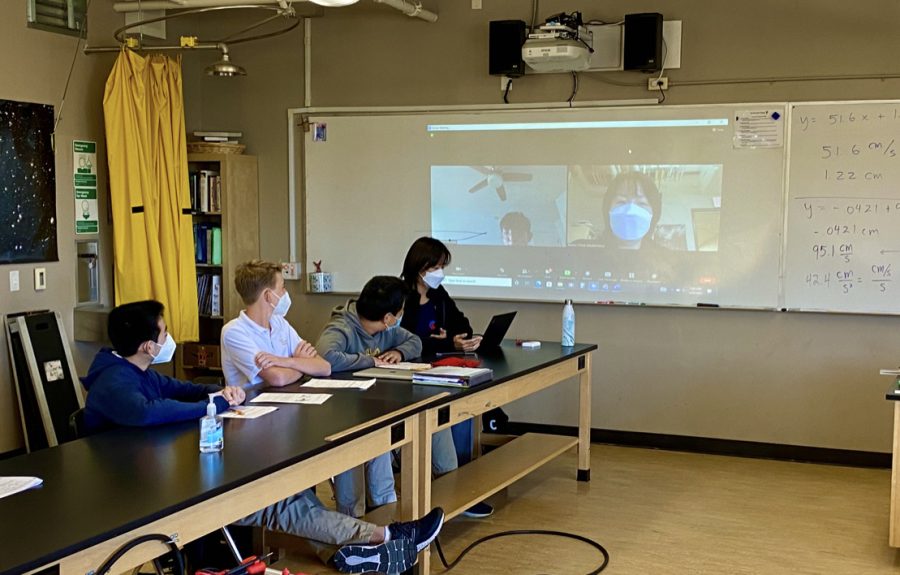On Mute
What’s up with view-only Zoom?
In classrooms across Bishop’s, accommodations are now necessary for students on Zoom. In Ms. Rachel Ching’s Physics class, lectures are now given to a screen so students on Zoom are able to hear.
To Zoom or not to Zoom? That is the question that is floating in the minds of students in isolation or who have fallen ill with COVID-19.
On Sunday, January 9, Knights News released a statement notifying the Bishop’s community that quarantined students could view class online instead of missing out on the lessons when absent. “It will be possible for isolating or quarantining students who feel well enough to observe classes via Zoom if it’s appropriate for that day’s lesson,” they said. At Bishop’s, students and teachers are having a mix of reactions, revealing the benefits and the drawbacks that the community is experiencing.
“Over the winter break,” Dean of Students Ms. Michelle Shea stated, “[The administrators] were pretty clear that we would probably have a high number of absences—of employees and of students—for a brief time.” She went on to explain that the administration realized that the spread of the Omicron variant was different in a way that students were still well enough to attend class, but on Zoom.
The Centers for Disease Control and Prevention (CDC) last updated its quarantine guidelines on January 27, 2022, advising that people who were either in contact with COVID or contracted the sickness should watch for symptoms of COVID-19 and “stay home and away from other people for at least 5 days (day 0 through day 5) after your last contact with a person who has COVID-19.”
Ms. Shea and the administration detailed the purpose of view-only Zoom as a temporary solution to relieve anxiety for students at home while prioritizing the students who were in-person, with the assumption that students online would not be out for a very long time.
Science teacher Dr. Anthony Pelletier approves of view-only Zoom, saying, “For those at home, it might not be as good as hybrid [classes], but [view-only] serves the purpose of making in-person classes as close to normal as possible.”
Bishop’s Daily Bulletin, on Thursday, January 20, released another statement regarding absences when students are online. “If you are absent from school because you are following COVID protocols, you will be marked absent but we will make a note in our system and distinguish those absences from other types of absences,” they said. Students do not lose credit for missed work during their absence if they make it up after they return and communicate with their teachers. However, under the “Attendance Summary” tab on Blackbaud, the absence is still counted.
Although she thinks view-only zoom is a great solution to those who are at home, Ashley Sottosanti (‘22) feels that being on Zoom due to COVID protocols and to keep others safe is not the same as an absence.
“Overall, I was experiencing the same things and completing the same work as everyone who was in-person, so why does that not equate to me being present? Being on Zoom is definitely way closer to being present than it is to being absent, so while I understand that some distinction should be made, I do not think considering people absent is the right one,” she said.
However, it is important to keep in mind that the amount of participation a student has in a class depends on the subject. For classes like math and science that require all students, regardless of setting to listen in on lectures, their participation is not altered as much. In contrast, classes that are more discussion and collaborative-based, make it much harder to count the viewing students as participants in class discussions.
Oliver Morrison (‘25) felt that it was easier to follow along with the lecture classes because the teacher usually had slides or a PowerPoint that he just needed to pay attention to. However, he said, “with classes like English and history it was much harder [to participate].”
Besides the controversial actions taken towards people who are “absent,” some students at home praised the change. Reagan Kliber (‘24) said, “I’m really grateful that Bishop’s has given its students the opportunity to continue learning from home when obstacles prevent them from attending in-person school.”
But why was view-only Zoom used instead of the hybrid learning system from last year where students could be active participants in the class? From a teacher’s point-of-view, “hybrid classes were extremely difficult,” Dr. Pelletier explained. “The mixture of some present [students] and some remote all trying to interact was very difficult. The consensus was that in-person learning suffered during hybrid classes,” he said.
Because of this issue, the administration wanted to keep instruction in-person as much as possible, opting not to complicate the classroom environment with the additional pressures of connecting the two settings.
However, from a student’s perspective, Reagan preferred last year’s hybrid learning to this year’s view-only option. “[Hybrid learning] offered me enough time to see my friends and develop new relationships with others, while also giving me some much needed time for silent study, in which I learned how to be disciplined in getting my work done rather than getting distracted,” she said.
Reagan revealed her personal feelings on view-only zoom. “I haven’t found it at all difficult to speak or participate in view-only classes. My teachers have all been tremendously helpful in making sure that I’m included in class activities,” she said. In addition, Reagan found view-only classes as not only a helpful way to stay in tune with the latest lessons but a great way to give ill students time to rest and get better.
Agreeing with Reagan, Ashley said, “[My] teachers didn’t treat me any differently beyond the fact that I interacted with them less because they were in a different room physically.”
Reagan and Ashley’s experiences on view-only Zoom demonstrate the inconsistencies that came with the system. Some teachers may follow the guidelines set by the administration and others find it difficult to not interact with their students, so the system is not ‘view-only’ for some cases. This affects the learning environment on Zoom and varies the different responses to the change.
Despite Reagan and Ashley’s generally positive experiences, Ella Willingham (‘25), who also went on view-only Zoom proved that student experiences may differ. “It is a great way to help kids that will be out for a few days with COVID because you don’t miss a lot of class and don’t get behind [in your classes],” she stated. However, she also said that in the long-term, it was not ideal because the lessons are overall hard to understand and learn online.
The temporary nature of view-only zoom is apparent as Ella went on to state that she felt her learning was, in fact, affected. “Online you cannot ask as many questions when you don’t understand [the material],” she said.
Although view-only zoom may seem like a compromised learning experience to students online, it is a way for students at home to feel comfortable with class material when they return while putting on-campus learning first.

Summer is a senior and Editor-in-Chief of The Tower. This is her fourth year on the staff and third on the editorial team, previously serving as a story...






